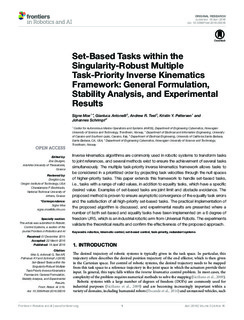| dc.contributor.author | Moe, Signe | |
| dc.contributor.author | Antonelli, Gianluca | |
| dc.contributor.author | Teel, Andrew R. | |
| dc.contributor.author | Pettersen, Kristin Ytterstad | |
| dc.contributor.author | Schrimpf, Johannes | |
| dc.date.accessioned | 2018-01-03T09:17:12Z | |
| dc.date.available | 2018-01-03T09:17:12Z | |
| dc.date.created | 2016-04-18T12:41:36Z | |
| dc.date.issued | 2016 | |
| dc.identifier.citation | Frontiers in Robotics and AI. 2016, 3 (16), . | nb_NO |
| dc.identifier.issn | 2296-9144 | |
| dc.identifier.uri | http://hdl.handle.net/11250/2474247 | |
| dc.description.abstract | Inverse kinematics algorithms are commonly used in robotic systems to transform tasks to joint references, and several methods exist to ensure the achievement of several tasks simultaneously. The multiple task-priority inverse kinematics framework allows tasks to be considered in a prioritized order by projecting task velocities through the null spaces of higher-priority tasks. This paper extends this framework to handle set-based tasks, i.e., tasks with a range of valid values, in addition to equality tasks, which have a specific desired value. Examples of set-based tasks are joint limit and obstacle avoidance. The proposed method is proven to ensure asymptotic convergence of the equality task errors and the satisfaction of all high-priority set-based tasks. The practical implementation of the proposed algorithm is discussed, and experimental results are presented where a number of both set-based and equality tasks have been implemented on a 6 degree of freedom UR5, which is an industrial robotic arm from Universal Robots. The experiments validate the theoretical results and confirm the effectiveness of the proposed approach. | nb_NO |
| dc.language.iso | eng | nb_NO |
| dc.publisher | Frontiers Media | nb_NO |
| dc.rights | Navngivelse 4.0 Internasjonal | * |
| dc.rights.uri | http://creativecommons.org/licenses/by/4.0/deed.no | * |
| dc.title | Set-based Tasks within the Singularity-robust Multiple Task-priority Inverse Kinematics Framework: General Formulation, Stability Analysis and Experimental Results | nb_NO |
| dc.type | Journal article | nb_NO |
| dc.type | Peer reviewed | nb_NO |
| dc.description.version | publishedVersion | nb_NO |
| dc.source.pagenumber | 16 | nb_NO |
| dc.source.volume | 3 | nb_NO |
| dc.source.journal | Frontiers in Robotics and AI | nb_NO |
| dc.source.issue | 16 | nb_NO |
| dc.identifier.doi | 10.3389/frobt.2016.00016 | |
| dc.identifier.cristin | 1350942 | |
| dc.relation.project | Norges forskningsråd: 223254 | nb_NO |
| dc.description.localcode | Copyright © 2016 Moe, Antonelli, Teel, Pettersen and Schrimpf. This is an open-access article distributed under the terms of the Creative Commons Attribution License (CC BY). | nb_NO |
| cristin.unitcode | 194,63,25,0 | |
| cristin.unitname | Institutt for teknisk kybernetikk | |
| cristin.ispublished | true | |
| cristin.fulltext | original | |
| cristin.qualitycode | 1 | |

